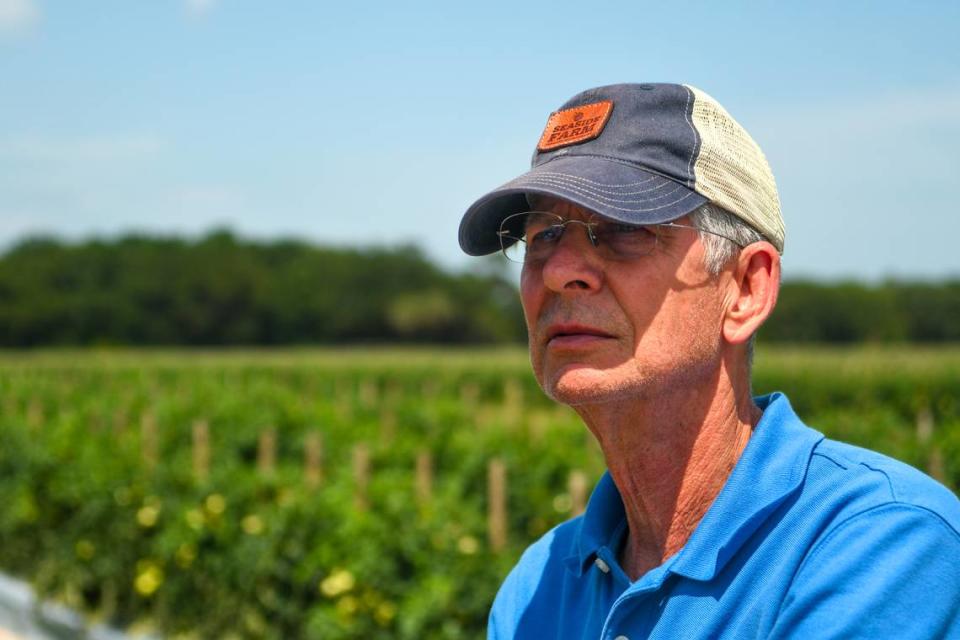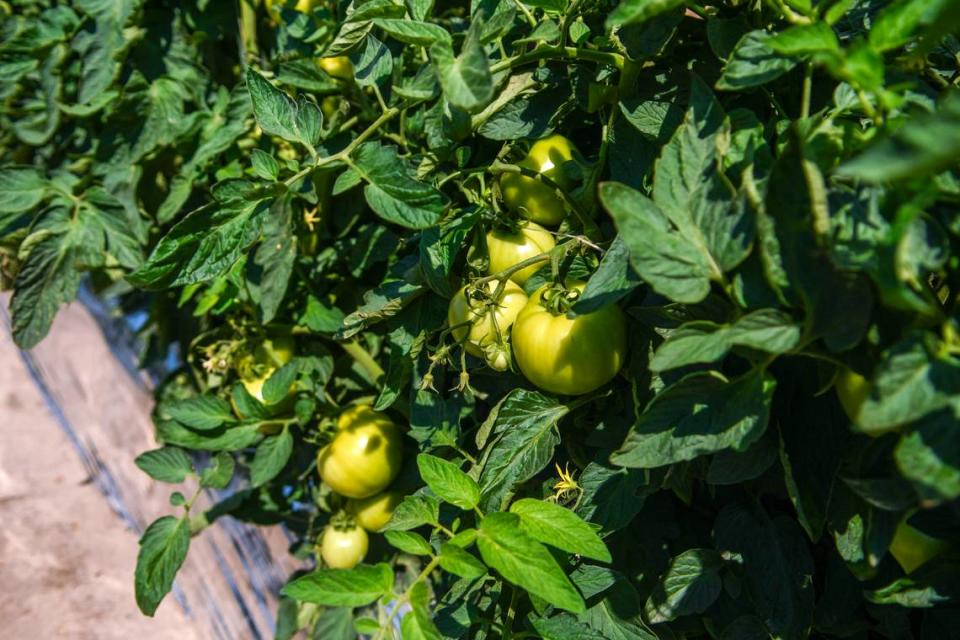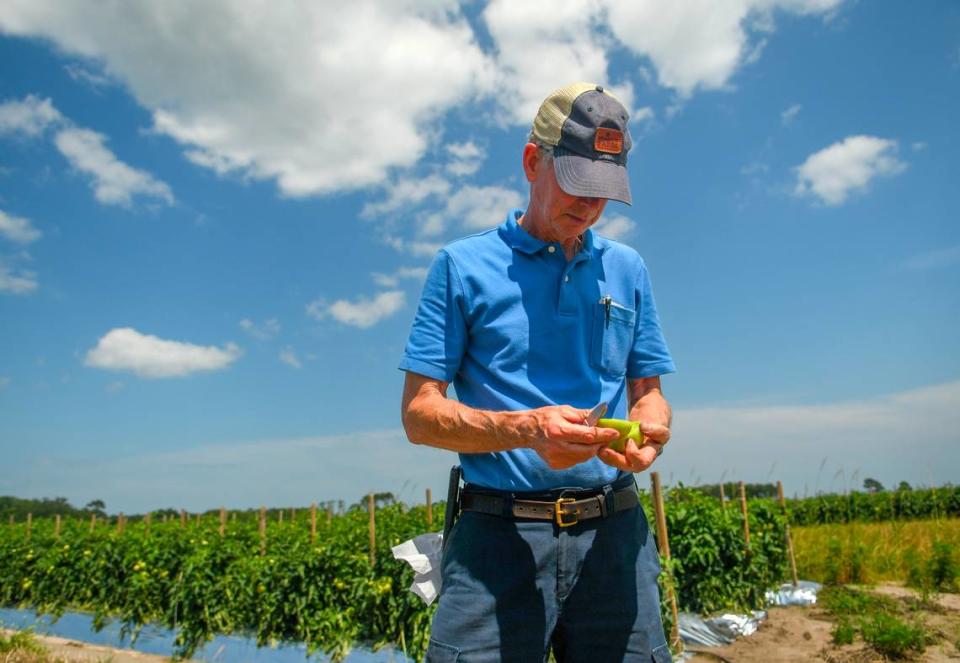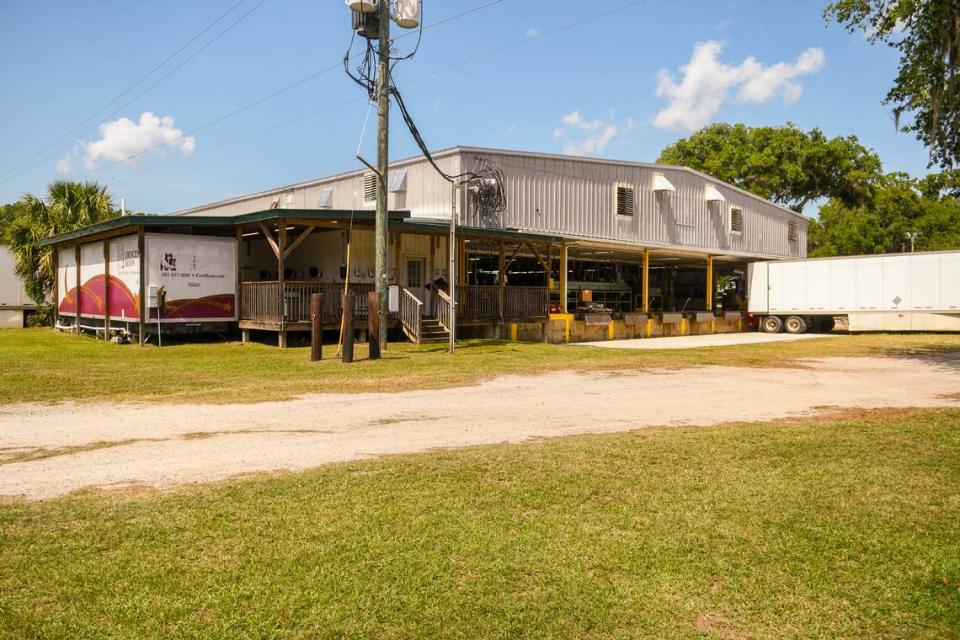St. Helena Island supplies East Coast with tomatoes. ‘The Lord has been good to us’
Mac Sanders, standing in one of the fields on his St. Helena farm in an endless sea of tomatoes, carefully makes a thin incision into a tomato’s green flesh, checking its seedy innards for ripeness. This tomato was grown alongside another 15-20 million pounds he and his crews will begin shipping in a few days. The final destinations are primarily hamburger or sandwich toppers but some will likely end up in salads, salsas and stews all up and down the east coast.
All around Sanders feet are white plastic liners carefully placed at the bottom of the long rows of tomatoes, which are five and a half feet apart. This practice, known as ‘plasticulture,’ helps conserve water, fights weeds and keep the plants elevated. Each plant was tied closely to a stake, popular perches for chatty birds.
“It’s what I’ve done all my life,” says Sanders.

The 70-year-old Sanders, the co-owner of the 1,000 acre Seaside Farm with a brother and two sisters, still gets excited come harvest time. He currently has tomato plants on 350 acres which is roughly equivalent to 265 football fields.
The fourth-generation tomato farmer, whose great granddaddy Gus started the island’s first commercial-scale tomato operation more than 120 years ago, says the family-owned business will hire more than 400 temporary employees to harvest the tomatoes — each one by hand.
Seaside Farm alone typically ships this massive amount of tomatoes to market in the month of June, processing three-quarters of a million 25-pound boxes of tomatoes at its packing house on Sea Island Parkway.
It’s easy to understand where these boxes full of ripening tomatoes will end up, everywhere east of the Mississippi, from Canada to Puerto Rico.
“We’re about a small as we can be and still be viable,” Sanders says.
But for a 4- to 6-week window in June to early July, tiny St. Helena Island is a big player in the East Coast tomato market, says Zach Snipes, a horticulture extension agent at Clemson University.
South Florida tomatoes hit the market first, in January and February, Snipes says. Production gradually moves north.
“Then, come June in South Carolina, the Sea Islands really supply the East Coast with tomatoes,” Snipes says.
Almost any tomato placed on a Burger King Whopper or sold in a grocery story on the East Coast from June 1 to July 4 will have been grown in Beaufort County, primarily St. Helena Island, Snipes says.
Tomatoes ripening
As of 2017, there were 729 farms growing tomatoes on 2,805 acres of tomatoes in South Carolina, according to the state Department of Agriculture. That’s the most recent year data was available. Snipes said commercial farms in Beaufort County make up the bulk of production in the state.
Each spring, in March and April, Seaside and Lipman Family Farms, St. Helena Island’s two main commercial tomato growers, set tomato plants.
They thrive in the area’s well-drained and loamy fine sand and coastal temperatures where they are protected, most of the time, from killing frost.
“We’re blessed to be where we are,” Sanders says.

Tomatoes are ripening now. Depending on the weather, harvest could begin this week, which will turn the rural island into a beehive of activity, drawing hundreds of migrant workers and semi tractor-trailer rigs to the area to harvest and transport the crop.
Cotton used to be king
Long and silky Sea Island cotton used to be king on St. Helena.
Today fresh red tomatoes, harvested when they are a mature green, are profitable.
“Tomatoes are quite valuable if you get them to the market fresh,” says Larry Rowland, professor emeritus of history at the University of South Carolina Beaufort and co-author of the three-volume history of Beaufort County. “That’s where good money is made.”
Before the Civil War, and even many years after, St. Helena was mostly devoted to cotton, Rowland says.
But the price of cotton declined in the 1880s because of competition and the traditional crop began to die away, Rowland said. The final nail in the coffin was the boll weevil, in 1917.
Two developments spurred the interest in vegetable growing. One, vegetables could be shipped to market via steamboats that made regular runs from Charleston and Savannah to New York, and later, by rail. Second was demand for Irish potatoes.
“In the 1930s they began to grow tomatoes because the profits were higher,” Rowland said. “Fresh tomatoes were in demand for everything.”
‘Slicers’ sold up and down coast
Sanders has lived his entire life on the island except the years he spent at Clemson University, where he studied engineering. His brother, Gray, is the farmer in the business. Sisters Lea Taylor and Caroline Hatcher are part-owners. Now, members of the fifth generation are learning how to farm, Mac jokes, so he and Gray can retire.
In the 1950s and 1960s, Sanders recalls, tomatoes were planted all over Beaufort County. Back then, he says, there were at least a dozen packing plants. Today, two remain.

“We’re the holdouts,” Sanders says. “It has been good to us.”
Tomatoes grown at Seaside, Sanders says, are mostly sold to middlemen and then redistributed, ending up at auction houses, restaurants, food service and grocery stores, tickling the taste buds of consumers from Chicago to New York.
“They’re slicers you can put on a sandwich mostly,” Sanders says.
Drip irrigation improves production
Sanders’ great granddaddy Gus, a truck farmer, decided in the early 1900s to focus on tomatoes and Beaufort County’s first commercial tomato operation was born. At that time, Sanders said, produce was moved by barge from Station Creek and up the Beaufort River to the Port of Port Royal, where they were loaded on trains.
In 1984, Sanders father was the first in Beaufort County to use drip irrigation. In the first year, tomatoes per acre increased from an average of 1,300 to 2,200.
“People heard about that yield all up and down the coast,” Sanders said.
Snipes, the Clemson extension agent, says he’s amazed by the volume of tomatoes produced by the St. Helena commercial tomato growing operations, and their logistical expertise. Growing tomatoes, he notes, is as much about logistics as it is about farming. And getting crops from the field to market, at just the right time, requires them to be very dialed in to not only their production but also the market.
“If you have a load of tomatoes going to Chicago,” Snipes says, “you better be ready and have enough.”
Hundreds of workers hired
Seaside has three main fields in the Frogmore area that are also used to grow a fall watermelon crop.
One day earlier this week, on the eve of the harvest, Sanders visited a large field off of Seaside Road facing Port Royal Sound, and just a few miles, as the crow flies, from Hilton Head Island.
Row-upon-row of green fruit hung from leafy plants, fueled by the sun and rich, sandy soil — and drip irrigation. The clock was ticking.
“It hasn’t completely jelled yet,” says Sanders, inspecting the insides of a tomato, which needs more firmness to hold its seeds before it can be picked.
Through the H-2A work program, which allows U.S. employers to bring foreign nationals to the United States to fill temporary agricultural jobs, Seaside will hire 300 workers to hand-pick the tomatoes, and another 150 will work in the packing house.

Workers who pick tomatoes in Beaufort County are primarily from Mexico, with some from Guatemala and Haiti, Snipes said.
“If we can’t get people to pick the crop,” says Sanders, “we’re done.”
When will the tomatoes mature? Will the markets hold? The weather? Each year, these are the questions faced by tomato growers like Sanders. Growing tomatoes, Sanders says, can sometimes be more art than science.
Thunderstorms can wash away plants. Frost can kill them. Florida can dump too many tomatoes into the market. Sun is needed at the right time. Some years, growers make a killing; other years, they struggle to break even.
Sanders is looking forward to another harvest.
“The Lord has been good to us,” Sanders says.

 Yahoo Sports
Yahoo Sports 